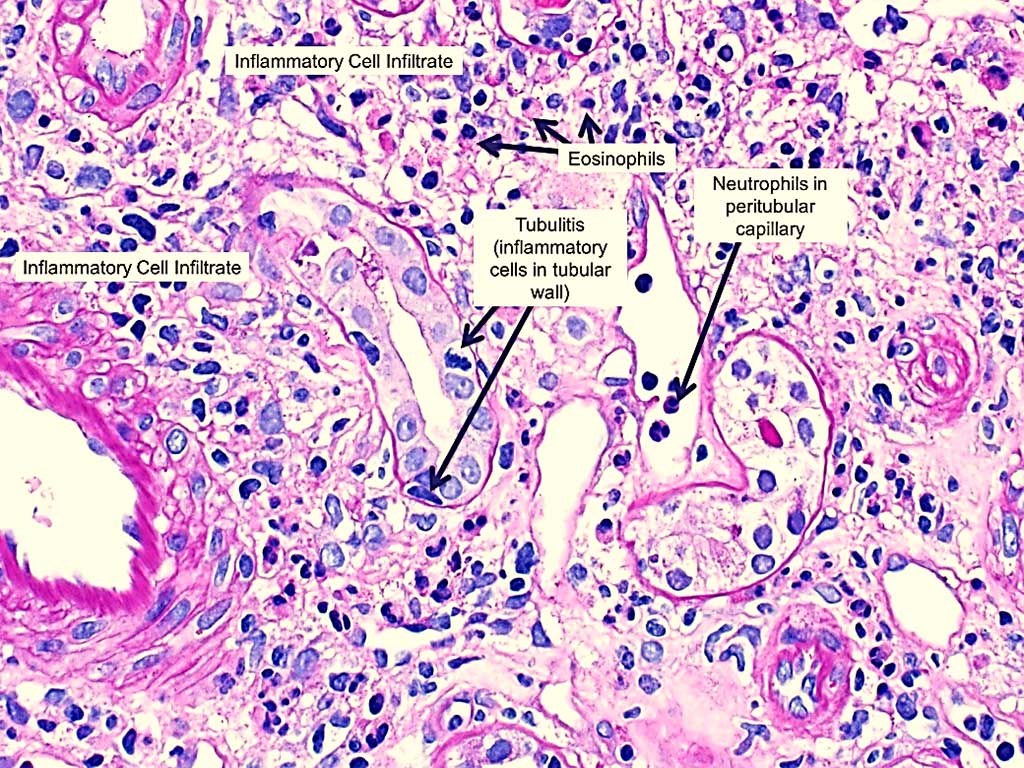Biomarkers Evaluate Kidney Injury in Cancer Patients
By LabMedica International staff writers
Posted on 17 Feb 2021
Immune checkpoint inhibitors (ICI) are monoclonal antibodies that can unleash the immune system by blocking surface molecules that serve as important breaks (or checkpoints) that mediate negative regulation of T cells. ICI have substantially improved the prognosis for patients with a wide range of malignancies.Posted on 17 Feb 2021
ICI therapy may induce a variety of immune related adverse events (iRAEs), including nephrotoxicity. The incidence of iRAE in patients receiving ICI can be as high as 85% depending on the target and the use of mono- or combination therapy. The most commonly affected organs are skin, endocrine glands, gastrointestinal tract, lungs and liver.

Image: Histopathology of drug-induced acute interstitial nephritis showing interstitial inflammation with prominent eosinophils and tubulitis (the presence of inflammatory cells within the tubular wall) (Photo courtesy of NephSim).
Nephrologists at the Mayo Clinic (Rochester, MN, USA) carried out a single center, retrospective observational study. They performed a search of the electronic medical records for all patients who had received an ICI and suffered an acute kidney injury (AKI) event between January 2014 and June 2020. There were 37 patients with ICI-AKI and 13 non-ICI AKI referents in the cohort for analysis. Clinical and laboratory features, including serum creatinine (SCr), serum C-reactive protein (CRP) and urine retinol binding protein/ urine creatinine(uRBP/Cr) levels at AKI event were evaluated.
The scientists reported that At time of AKI, SCr, CRP and uRBP/Cr were significantly higher in the ICI-AKI compared to the non-ICI-AKI patients (median [IQR] serum creatinine 2.0 [1.7, 2.9] versus1.5 [1.3, 1.6] mg/dL, serum CRP 54.0 [33.7, 90.0] versus 3.5 [3.0, 7.9] mg/L and urine uRBP/Cr 1,927 [1,174, 46,522] versus 233 [127, 989] mcg/g Cr, respectively). Compared to the referent group, time from ICI initiation to AKI was shorter in the ICI-AKI patients. Among the ICI-AKI group, complete renal recovery occurred in 39% of patients by three months; rechallenge occurred in 16 (43%) of patients, of whom three (19%) had recurrence of AKI. A pattern was observed with eGFR, which decreased in the ICI-AKI group as compared to the non-ICI-AKI at the time of AKI (median 28.9 [16.7, 37.8] versus 40.6 [38.9, 46] mL/min/1.73m2, respectively.
Sandra M. Herrmann, MD, a Nephrologist and the study's senior author, said, “Immune checkpoint inhibitors have improved the prognosis for patients with a wide range of malignancies including melanoma, non-small cell lung cancer and renal cancer. In some patients, this enhanced immune response may target kidney tissue, leading to acute kidney inflammation known as interstitial nephritis.”
The authors concluded that their study provided novel, important data for clinicians regarding the use of biomarkers in the routine evaluation of cause of AKI in patients on ICI therapy. These biomarkers could assist with discriminating ICI-AKI from other causes and may also help aid clinical decision-making related to both management and recurrence. They also described distinguishing clinical characteristics of patients with ICI-AKI, which may help with the diagnosis and possible prevention of ICI-AKI, by reinforcing the strategy of avoidance of acute interstitial nephritis (AIN) associated drugs in this type of patient. The study was published on February 1, 2021 in the journal Kidney International Reports.
Related Links:
Mayo Clinic














